"We are what we repeatedly do. Excellence, then, is not an act, but a habit." --Aristotle
Address any questions or comments regarding this newsletter to the individual authors listed after each article or to its editor, Rick Weinzierl, 217-333-6651, weinzier@illinois.edu. To receive e-mail notification of new postings of this newsletter, call or write the same number or address.
In This Issue:
Upcoming Programs (for beginning and established growers)
Regional Reports (from southern and western IL and the Kankakee area)
Fruit Production and Pest Management (spotted wing Drosophila update)
Vegetable Production and Pest Management (downy mildew of basil; squash vine borer and squash bug)
Upcoming Programs
Check the Illinois SARE calendar for a full list of programs and links for registration.
http://illinoissare.org/ and http://illinoissare.org/calendar.php
Also see the University of Illinois Extension Local Food Systems and Small Farms Team's web site at:
http://web.extension.illinois.edu/smallfarm/ and their calendar of events at http://web.extension.illinois.edu/units/calendar.cfm?UnitID=629.
- Dixon Springs Field Day, August 7, 2014. 9:00 a.m. – noon, University of Illinois Dixon Springs Ag Center, Simpson, IL. For more information, call 618-695-2441. http://web.extension.illinois.edu/units/event.cfm?UnitID=629&EventID=65613.
- Pumpkin Field Day, September 4, 2014. 10:00 a.m. at the Ewing Demonstration Center, Ewing, IL (about 20 minutes south of Mt. Vernon; 4 miles east of I-57) ½ mile north of the Ewing Northern School off of Main Street) For more information contact Nathan Johanning at 618-687-1727 or njohann@illinois.edu.
- Southern Illinois Summer Twilight Meeting Series, September 15, 2014. 6:00 to 8:00 p.m. On farm program at Lipe Orchards, Carbondale, IL. Pre-registration (at no cost) is required; see http://web.extension.illinois.edu/ghhpsw/ or contact Bronwyn Aly at 618-382-2662 or baly@illinois.edu.
- Preparing a New Generation of Illinois Fruit and Vegetable Farmers, December, 2014 – November, 2015. Aspiring farmers, new growers with less than five years' experience, commodity farmers interested in diversifying to include fruit or vegetable production, and high school and community college agriculture teachers are invited to apply for the next session of a free training program offered by the University of Illinois at Dixon Springs, Urbana, and St. Charles, IL. For more information, see http://newillinoisfarmers.org/ and http://news.aces.illinois.edu/news/new-illinois-farmers-program-accepting-applications-third-session.
- Mark your calendars … for the Illinois Specialty Crops, Agritourism, and Organics Conference, January 7-9, 2015, at the Crowne Plaza Hotel and Convention Center, Springfield, IL.
Regional Reports
In southern Illinois ... Overall, as of July 22, we are fairly dry, with many fields in need of a good rain. Cool weather last week, with highs in the upper 70s to 80 and lows in the 50s, slowed the maturation of some crops, such as tomatoes and sweet corn; however, many crops did appreciate the break from heat stress while still having bright sunny days to fuel growth. By last weekend we were back up to the mid-80s for highs and have temperatures around 90 the first part of this week.
Sweet corn has been doing very well this year, with many reports of very low corn earworm pressure. However, some growers have had issues with bird damage. Early peaches are in harvest, and Red Haven harvest is just starting, with growers reporting good quality and yield so far. Other produce that is starting to show up in markets includes melons, plums, and new potatoes.
We have had multiple reports of spotted wing Drosophila in brambles, including in Randolph and Monroe counties (among many others), so if you are growing any brambles, make sure you are monitoring and managing these pests to maintain good fruit quality!
At home I've been starting to harvest new potatoes. Due to cool wet conditions after I planted, I did not get the greatest stand, but the plants that did come up really thrived with the modest summer temperatures we have had, along with adequate moisture. Currently we are about 3 weeks after flowering, and the vines are still heathy and green with good tuber development.

Potato growth and yield on 'Kennebec.' Photo: Nathan Johanning
Over the weekend I no-till transplanted a fall crop of broccoli into cereal rye residue. I have found that in my area this is a great way to raise broccoli (and other cole crops), because they can mature in the cooler weather late September into October and I can continue to harvest side shoots until we get temperatures down to around the low 20s. The biggest challenges will be maintaining good soil moisture, especially until plants are established, and then scouting and controlling insects. Insect management is crucial once the head starts to form, as once an insect gets established inside the head, it is very difficult get spray coverage to control them.
Nathan Johanning (618-939-3434; njohann@illinois.edu)
From western Illinois ... A little over 6 inches of moisture in June came in the nick of time, as crops were beginning to feel the effects of dry soil conditions. Crops responded favorably to the moisture, and growth during June was phenomenal. However, since the end of June, we've had only 1.7" of rain. Early planted crops have a good root system, but there really isn't a lot of moisture reserve in the top soil in the Quincy area. We repaired a tile hole over the weekend, and it was fairly dry down to the four foot depth. And I noticed some of the late planted pumpkins were wilting a little on Sunday.
We've not had the excessive rains or high winds that have affected other areas of the state. Field corn has never looked this good over such a widespread geographic area. All of it is dark green in color and thriving.
Summer vegetable crops have been very good thus far. Sweet corn is filled out to the tip, high tunnel tomatoes are excellent, as are peppers, and the green bean crop has had multiple pickings (due to adequate rains). Onions have been huge. Early planted pumpkins have been runnering, and flowering began recently.
Corn earworm trap catches have dropped dramatically the past two weeks, and field corn silking began as well, so pressure for earworm infestation of sweet corn has been fairly low. Squash bug eggs can be found on cucurbit crops, along with cucumber beetles, so take time to scout fields and treat accordingly. I'm finding more European corn borer injury in some of our sweet corn than I'd like. I knew we had some infestations, we do every year, but I didn't treat this year. Lesson learned.
With the great weather conditions for crops, you know the weeds are also doing well. We've had multiple flushes of waterhemp (and other weeds), so keeping fields clean has been a challenge. All the pre emerge products applied this spring are close to or past their prime.
Fungal diseases (septoria leaf blight and early blight) are appearing in field tomatoes. In home gardens, mulching to prevent soil splash can dramatically reduce incidence. The pathogen survives in soil and rain splashes soil onto lower leaves. As new infections sporulate, they spread upward by more splashing rains. Rotation also helps reduce initial infection, and there are several fungicides labeled to help provide control http://www.btny.purdue.edu/pubs/id/id-56/ID-56.pdf .
Tomato leaf mold is still active in high tunnels, and I've seen a few tunnels with spider mite activity. For those who manage shade cloths on tunnels to moderate temperatures, it has been a season (thus far) of on and off and on and off. This past week's low temperatures caused a disruption in maturity for a number of crops. All the heat-loving summer vegetables just about quit growing and harvest was down.
We finished the second year of our matted row strawberry trial this spring. We used eight varieties, in four replications. Results are available on the U of IL Local Foods/ Small Farms web site http://web.extension.illinois.edu/smallfarm/.
Mike Roegge (217-223-8380; roeggem@illinois.edu)
In the Galesburg area ... Garlic harvest has begun here and around the state. It was a rather uneventful year for garlic...and that is just how we like it! As I have mentioned over the past year, we replicated demonstration plots across the state using a winter killed cover crop (oats) for weed control in garlic. I won't bore you with the statistics, suffice to say, this practice did not prove to give satisfactory control of weeds throughout the growing season for the garlic crop. This was evident even at 3X rates of a typical seeding of oats as a cover. On one farm, we witnessed a 50% decrease in size of the average bulb in the oat cover strips compared with a wheat straw mulch. Winter annual weeds were significant in that they were not controlled well at all. So, were these trials successful? Yes. The reason we do applied projects on the farm is to identify practices that work and those that don't. Our next step is to figure out how we can use other cover crops for weed control in garlic. For example, cereal rye would likely do well smothering weeds, especially our winter annuals, but ... how do we terminate a cereal rye cover crop without affecting the growing garlic? Maybe we can't. If you are trying similar practices, I would like to visit with you to see what you are doing.
In other happenings, the Galesburg area is one of the few in the state with Japanese beetle issues this year. Without a doubt, the populations are low compared to last year, but we have seen significant leaf feeding on some crops. I was on a farm yesterday that had a healthy population munching on potatoes and grapes. This is proving to be good year for Allium crops (onions, leaks, garlic and shallots). Shallots especially seem to be taking a foothold at markets. If you have never cooked with shallots, they have the intense flavor of onions but don't have the "bite" of an onion. Chefs use shallots consistently in many recipes. Ask around, there might be a demand that is unfulfilled for the crop.
Hope everyone's harvests are going well.
Kyle Cecil (309-342-5108; cecil@illinois.edu)
Around Kankakee ... Tomato diseases (bacterial spot and/or bacterial speck, as well as fungal diseases) are common in the area, as they are in other locations where frequent rains and winds have contributed to infections. The Midwest Vegetable Production Guide for Commercial Growers lists bactericides and fungicides that protect against infections. Because some common bacterial and fungal diseases may look quite similar, accurate identification of diseased plants is necessary if the right products are to be selected to prevent further disease spread. The University of Illinois Plant Clinic provides disease identification services ... contact them at http://web.extension.illinois.edu/plantclinic/, 217-333-0519, or email Suzanne Bissonnette at sbissonn@illinois.edu.
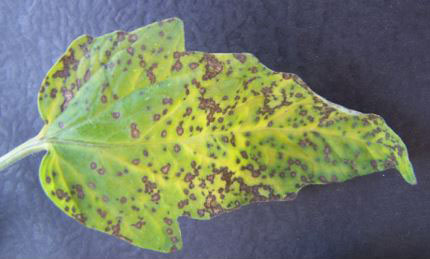
Tomato leaf with disease symptoms.
James Theuri (815-933-8337; jtheu50@illinois.edu)
Fruit Production and Pest Management
Spotted Wing Drosophila Update
By now I have received reports of spotted wing Drosophila captures on traps or infestations in fruits (mostly raspberries and blackberries) from far southern Illinois to near the Wisconsin border. We continue to trap adults around untreated small fruits at the University of Illinois Fruit Research Farm at Urbana, and we have isolated larvae and reared adults of SWD from blueberries, red raspberries, black raspberries, blackberries, black currants, and mulberries here.
To determine if ripening fruit is infested, we use a high-concentration sugar water solution (1 cup of granulated white sugar in 1 quart of water) to float larvae from fruit so that we can see them. We place the fruit in portions of coarse mesh produce bags, cover it with water, and place a weight on top to sink the fruit below the surface. Larvae float to the top and wiggle on the surface. To date, the greatest number of larvae we have taken from a single sample is 272 larvae from a 50-gram sample of mulberries (around 50 berries).
See the May 15 (http://ipm.illinois.edu/ifvn/contents.php?id=43) and May 29 (http://ipm.illinois.edu/ifvn/contents.php?id=44) issues of this newsletter for details on the methods for trapping spotted wing Drosophila and effective insecticides that can be used for its control.
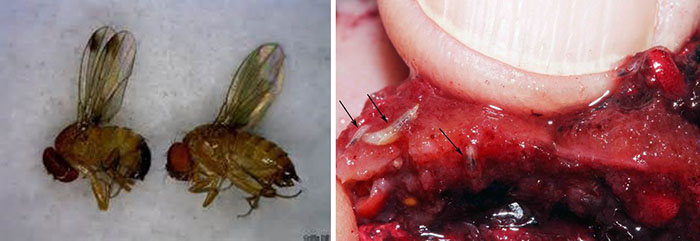
Left: Male and female adults of SWD. Right: SWD larvae in raspberry.
Rick Weinzierl (217-244-2126; weinzier@illinois.edu)
Vegetable Production and Pest Management
Downy Mildew of Basil in Illinois
In the past two weeks, downy mildew of basil was observed in commercial fields as well as nursery plants sold in a store. In 2014, we observed this disease earlier than the past five years. It is the time to make all needed efforts to keep the disease under control. Otherwise, losses of the crops could approach 100%.
Downy mildew of basil, caused by the oomycete pathogen Peronospora belbahrii, has been occurring in Illinois since 2009. The major symptom of the disease is yellowing on the upper leaf surfaces, which resembles nutritional deficiency. The downy-appearing sporulation of the pathogen develops on the lower leaf surfaces. The pathogen can be observed using a hand lens or a microscope. Downy mildew of basil is effectively controlled by application of fungicides. Azoxystrobin (Quadris), cyazofamid (Ranman), mandipropamid (Revus), and potassium phosphite (ProPhyt) have been labeled for use on basil. An effective control of basil downy mildew can be achieved by spray-application of Revus (8.00 fl oz/A) + ProPhyt (3-4 pt/A), alternated with Quadris (15.4 fl oz/A) + ProPhyt (3-4 pt/A) or Ranman (2.75 fl oz/A) + ProPhyt (3-4 pt/A). Recent weather conditions in Illinois have been very conducive for development and spread of downy mildew of basil. Weekly applications of the fungicides are needed to effectively control downy mildew of basil. Our studies in the past four years showed that adding adjuvants did not increase effectiveness of the fungicides. However, mixing Revus, Quadris, or Ranman with ProPhyt significantly increased effectiveness of the fungicides against the disease. For label information of Revus, Ranman, Quadris, and ProPhyt fungicides, refer to the following links: http://www.cdms.net/LDat/ld8FU004.pdf; http://www.cdms.net/LDat/ld7M7017.pdf; http://www.cdms.net/LDat/ld5QN022.pdf; and http://www.cdms.net/LDat/ld5KK008.pdf.
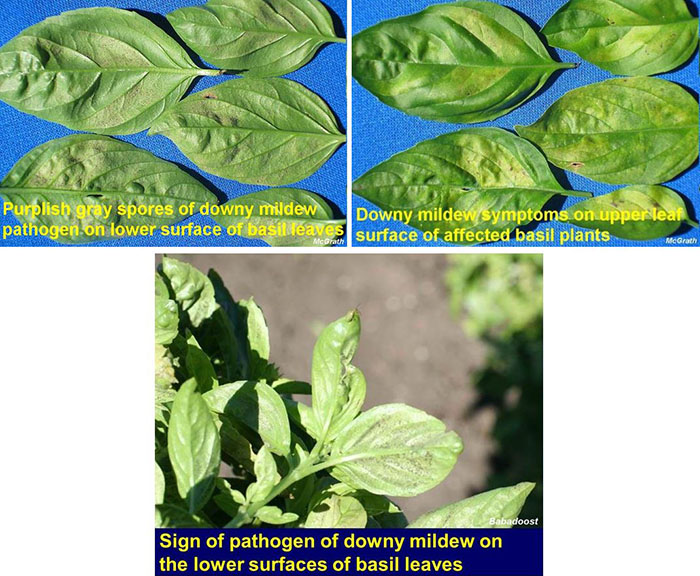
Mohammad Babadoost (217-333-1523; babadoos@illinois.edu)
Squash Vine Borer and Squash Bug
The squash vine borer tunnels in the vines of pumpkins and summer and winter squash; it rarely is found in cucumbers or melons and cannot complete its development except in squash or pumpkins.
Identification. The squash vine borer adult is a black and reddish moth called a clearwing moth because large portions of its hind wings lack scales. These moths are ¾- to 1-inch long, with a 1- to 1 ½-inch wing span. They are active during the daytime and superficially resemble wasps as they fly about. Larvae are yellowish-white with a brown head, 3 pairs of thoracic legs, and 5 pairs of fleshy abdominal prolegs that bear tiny hooks called crochets. Fully-grown larvae are about 1 inch long. Brownish pupae are slightly less than 1 inch long, and they are found in the soil inside a dark, silken cocoon.
Life Cycle. Squash vine borers overwinter as mature larvae or pupae within cocoons 1 ½ to 3 inches below the soil surface. Moths emerge and begin to mate and lay eggs in June and July in much of the Midwest (earlier, beginning in May, in southern Illinois and similar latitudes). Moths lay eggs singly at the base of plants or on stems and petioles, beginning when plants start to bloom or "run". Larvae feed within stems or petioles for 2 to 4 weeks, leaving brown, sawdust-like frass (droppings) at holes where they entered the stem. In southern Illinois these pupate and produce a second flight of moths in late summer; in the north, larvae or pupae of the first (and only) generation remain in the soil through the winter.
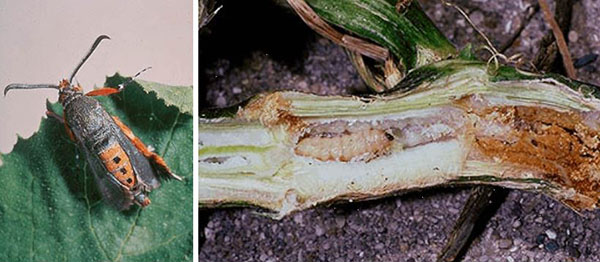
Squash vine borer adult (left) and larva (right).
Plant Injury. Tunneling within vines destroys water- and food-conducting tissues, reducing plant vigor and yield and sometimes killing vines.
Management. Disking or plowing to destroy vines soon after harvest and bury or destroy overwintering cocoons reduces moth populations within a field in the spring. Staggering plantings over several dates also allows some plantings to escape heaviest periods of egg-laying. Early detection of moths and initial damage is essential for timing insecticide applications. For insecticides to be effective, they must be applied before larvae enter stems or petioles. Scout for moths (pheromone lures and traps are available for monitoring flight periods but are not consistently effective for detecting moth flight) and look for entrance holes and frass as soon as plants begin to bloom or vine. Apply insecticides beginning 5 to7 days after moths are first detected and at weekly intervals for 3 to 5 weeks, or begin when injury is first noted and make a second application a week later. See the 2014 Midwest Vegetable Production Guide for Commercial Growers for listings of registered insecticides.
Squash bug infestations typically begin in late June and July in Illinois. The squash bug, Anasa tristis (De Geer) (Hemiptera: Coreidae), is a perennial and severe pest of pumpkins and squash; it rarely injures cucumbers and melons in the Midwestern United States.
Identification. The squash bug is a "true bug" in the order Hemiptera. Like all adult Hemiptera, adult squash bugs have two pairs of wings, with the front wings hardened at the base and membranous at the tips. Its mouthparts form a needle-like beak that arises from the tip of the head. Adults are brownish black, with yellowish to red-orange markings; they appear oval shaped when viewed from above, and somewhat flattened when viewed from the side. Females lay yellowish-white eggs in small clusters or masses on the upper and lower surfaces of leaves; the eggs quickly darken to a reddish brown color. Eggs hatch to produce grayish-white, wingless nymphs with black legs. The nymphs darken in color as they grow older, and wing pads (the beginnings of adult wings) begin to develop.
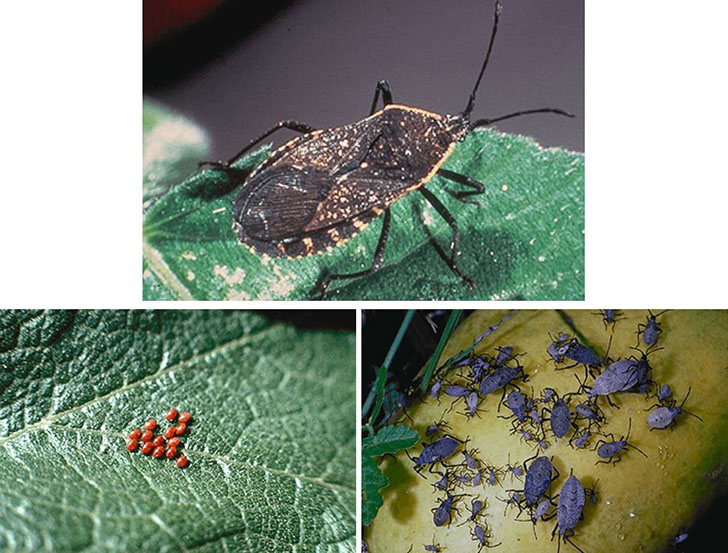
Squash bug adult (above), eggs (lower left), and nymphs (lower right).
Life Cycle. The squash bug overwinters as an adult, and survival is greatest in plant debris, mulch, and field borders or woods. Adults become active in the spring, mate, and females begin feeding and laying eggs in June and July. Nymphs grow to the adult stage in 5 to 6 weeks, and new females mate and begin laying eggs immediately. Populations are greatest during hot, dry summers. Females that reach the adult stage after late July or early August do not mate or lay eggs but instead enter an inactive stage and seek overwintering sites. Squash bugs may be present as nymphs or adults in pumpkins and squash from June through October.
Plant Injury. Squash bugs use piercing mouthparts to penetrate stems, leaves, and fruit and suck sap from plants. This direct damage may cause wilting or even kill plants if populations are great enough. Recent research has found that squash bugs transmit squash yellow vine disease; controlling squash bugs limits the spread of this disease within fields.
Management. Early in the season when adults move into fields and feed on young plants, watch for wilting of seedlings and apply an insecticide if wilting is observed. Scout for eggs of the squash bug on upper and lower surfaces of leaves. If densities exceed one egg mass per plant, use insecticides for control as nymphs begin to hatch. Insecticides labeled for use against squash bug are most effective against young nymphs, and for commercial growers who possess a Pesticide Applicator's License, the pyrethroid insecticides (particularly Brigade, Mustang Max, and Warrior) are most effective against squash bug. Organic growers may choose to use floating row covers to exclude squash bugs from young plants, but when row covers have to come off to allow pollination, none of the insecticides approved for use in Certified Organic production systems are truly effective against squash bugs. See the 2014 Midwest Vegetable Production Guide for Commercial Growers for listings of registered insecticides.
Rick Weinzierl (217-244-2126; weinzier@illinois.edu)
Local Foods Issues
Linking Pricing and Profitability for Producers
A group of University of Illinois Extension Local Food Systems and Small Farms Educators are collaborating with the University of Kentucky's Center for Crop Diversification to create an Illinois farmers market price report. The Center has been compiling price reports for farmers markets and produce auctions around Kentucky since 2005. In 2013, faculty and Extension personnel at the University of Tennessee started reporting prices from some of their farmers markets, and the Center was able to help them get the information out to Tennessee growers. This year, Illinois became a partner with the Center to create our own statewide price report.
The goal in sharing price reports with the public is to help farmers learn about prices that are being charged at farmers markets or produce auctions for common products. Having access to this pricing information allows farmers to better understand how to set prices that support profitability of their farm while remaining fair to consumers and competitive with other producers. Price and sales information is helpful to producers selling at farmers markets, produce auctions, and terminal markets. Farmers' market prices are collected weekly and reports are published to the website early the following week. By accessing these reports, producers can monitor fluctuations in prices and see which crops are available at the different locations or regions within the state. These reports are also very useful for new producers who are starting to market their products through various channels.
For our first year's efforts, we are collecting data at eleven markets, from Machesney Park to Harrisburg and from Quincy to Urbana. Each week, Extension Educators, program assistants, and/or Master Gardener volunteers collect information about the vegetable and fruit crops being sold. Information from each of the vendors is collected, and an average price for each commodity is reported for each of the markets. Price information from each of the markets is then aggregated into a weekly report. We are also conducting a one-time report for meat and egg sales.
To access farmers' market price reports for all three states, go to http://www.uky.edu/Ag/CCD/price.html. For more information, contact Farmers Market Price Report co-coordinators Deborah Cavanaugh-Grant, cvnghgrn@illinois.edu and Bronwyn Aly, baly@illinois.edu
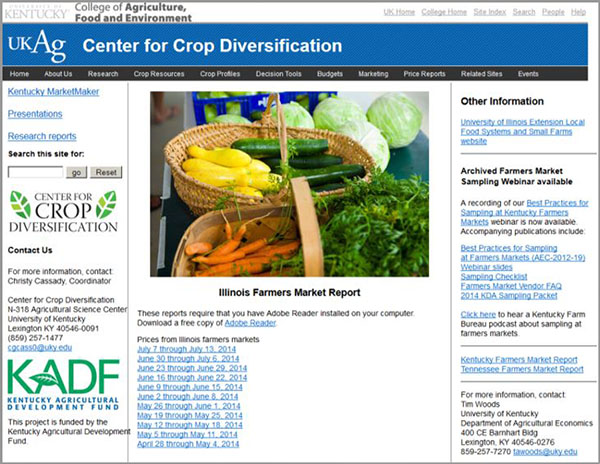
Deborah Cavanaugh-Grant (217-782-4617; cvnghgrn@illinois.edu)
University of Illinois Extension Specialists in Fruit and Vegetable Production & Pest Management
Extension Educators – Local Food Systems and Small Farms |
||
Bronwyn Aly, Gallatin, Hamilton, Hardin, Pope, Saline, and White counties |
618-382-2662 |
|
Katie Bell, Franklin, Jackson, Perry, Randolph, & Williamson counties |
618-687-1727 |
|
Sarah Farley, Lake & McHenry counties |
847-223-8627 |
|
Nick Frillman, Woodford, Livingston, & McLean counties |
309-663-8306 |
|
Laurie George, Bond, Clinton, Jefferson, Marion, & Washington counties |
618-548-1446 |
|
Zachary Grant, Cook County | 708-679-6889 | |
Doug Gucker, DeWitt, Macon, and Piatt counties |
217-877-6042 |
|
Erin Harper, Champaign, Ford, Iroquois, and Vermillion counties |
217-333-7672 |
|
Grace Margherio, Jackie Joyner-Kersee Center, St. Clair County |
217-244-3547 |
|
Grant McCarty, Jo Daviess, Stephenson, and Winnebago counties |
815-235-4125 |
|
Katie Parker, Adams, Brown, Hancock, Pike and Schuyler counties |
217-223-8380 |
|
Kathryn Pereira, Cook County |
773-233-2900 |
|
James Theuri, Grundy, Kankakee, and Will counties |
815-933-8337 |
|
Extension Educators – Horticulture |
||
Chris Enroth, Henderson, Knox, McDonough, and Warren counties |
309-837-3939 |
|
Richard Hentschel, DuPage, Kane, and Kendall counties |
630-584-6166 |
|
Andrew Holsinger, Christian, Jersey, Macoupin, & Montgomery counties |
217-532-3941 |
|
Extension Educators - Commercial Agriculture |
||
Elizabeth Wahle, Fruit & Vegetable Production |
618-344-4230 |
|
Nathan Johanning, Madison, Monroe & St. Clair counties |
618-939-3434 |
|
Campus-based Extension Specialists |
||
Kacie Athey, Entomology |
217-244-9916 |
|
Mohammad Babadoost, Plant Pathology |
217-333-1523 |
|